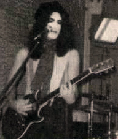 |
Paul Stanley |
In 1973 Paul Stanley of Kiss had LoBue and Lary Di Marzio switch out his pick guard and pickup in his stock
 |
Gene Simmons |
Flying V to custom pick guard and a single home wound pickup. LoBue later made him a custom V. LoBue made Stanley a double cut away with two pickups but it was stolen between the completion of the first album and the start of the tour. Stanley and LoBue then worked on a short wing Flying V and bound on the front like Albert King. During the recording of “Hotter than Hell” somebody walked into the studio and walked out with the guitar. LoBue also made a double cutaway bass for kiss bassist Gene Simmons which was also stolen.
LoBue made another guitar for Paul Stanley … a crescent moon design. Upon delivery, Stanley found that the shape was a symbol of evil according to his girlfriends’ religious beliefs. Stanley sold this guitar immediately to Eiichi Sayuu (deceased), a musician doing electronics work at Alex Music. The whereabouts of this guitar is unknown.
 |
Steve Khan Khancaster |
In concert with jazz musician Steve Khan, LoBue developed the Khancaster, a Telecaster fitted with specially designed LoBue pickup in the neck and micro switching polarity and phase switching. Khan indicated in a recent conversation that the Tele with the hot pickups helped to form the sound which he was known for. (He sold this guitar to John Tropea who later again sold it. Its current whereabouts is unknown.) This coil tapping wasn’t popular with Gibson or Fender for years to come. I own a Martin solid body built in 1979 which has coil tapping and DiMarzio SuperDistortion pickups stock as well.
 |
Dino Walcott |
One notable bass made at the time was for Dino
Walcott, long time session player in Europe and America.
Another bass bass made at this time was for Alphonso
Johnson then of Weather Report. This bass was equipped
with round pickups which LoBue was working on at the time. It is thought
that Johnson, then recording an album with Khan made the connection
to LoBue. One distinctive characteristic of this bass was that it
had small round pickups.
Sal "the Bassman" Congemi first made contact with LoBue when he
had his shop in midtown Manhattan at 701 7th. Sal was very impressed
with his work but didn't have enough money to have him build a bass.
At some point LoBue had gotten his own line of Bass Strings and
they were really great strings and Sal used them for a number of
years. Then when he bought a used early mid 70's Fender Tele Bass
that was painted Black with a paint brush and had a crappy Fender
humbucker in the neck position he decided to have LoBue work his
magic on it. By this time LoBue had moved to Thompson St. Charles
and Sal discussed what could be done with the bass andhe started
working on it. First the bass was striped and re-finished to a natural
wood finish with it's original black pick guard, and it's beautiful
maple neck all in place.
LoBue then did something that even today seems to have guitar builders scratching there heads when Sal talk sabout the Bass he customized, LoBue would mount the custom Pickups up-side down over the bass strings out of the body and then encouraged Sal to listen to them set up like that week after week, re-working the pickups until he was happy with the sound & position of them. He then made custom "wooden encasements" for the two pickups (ahead of his time) and set them into the bass body. The neck pickup was a large 8 pole humbucker with 2 poles for each string, with the poles being on the top & bottom of the pickup like a usual humbucker. The bridge pickup was made up of 2 jazz bass pickup (again ahead of his time) wound together into a humbucker with a total of 16 poles giving 4 poles per string. They were the most explosive & tonal bass pickups a bass player could ask for at that time.
The controls were set up with passive electronics and a master volume control, mini 3 position pickup toggle switch & a separate tone control for each pickup.
Unfortunately several years later the bass was damaged, and was un-playable & un-repairable. Sal reluctantly traded this bass to Sam Ash for a RD Artist.
|